Disclosure: Privacy Australia is community-supported. We may earn a commission when you buy a VPN through one of our links. Learn more.
Top 8 Best NBN Modems in Australia for 2024
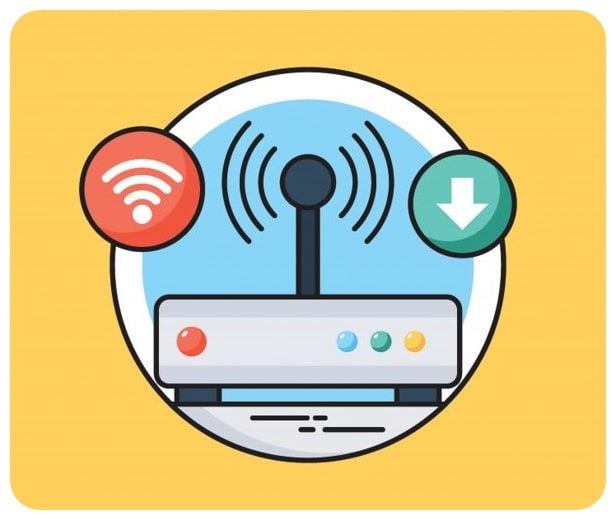
Are you a gamer? Streamer? Work on a cloud system that requires seamless access? Or just a casual internet browser?
Australia’s National Broadband Network is designed to transfer larger amounts of data for residential and commercial purposes, as it optimises fibre optic cables for hassle-free performance.
But if you have an old modem or router, accessing this technology won’t be that easy. It’s time to invest in this new technology and buy a new device.
NBN modems are designed to meet the specific requirements of Australia’s broadband infrastructure. They’re more reliable than older modems that were not built to work with the new technology.
So, are you ready to enter the future?
In this article, we’ll talk about the best NBN modems in Australia, evaluating their compatibility with NBN standards, speed capabilities, and other advanced features.
Speaking from first-hand experience, we tested real-world performance across various NBN connection types, analysed expert and user reviews, and considered technical specifications to answer this question—which NBN works best for you?
Table of Contents
- TL;DR
- Criteria Breakdown Summary
- NetComm NF20MESH CloudMesh
- Telstra Smart Modem 3
- TP-Link VX230v
- D-Link R15 Eagle Pro AI
- D-Link DIR-2150
- Sagemcom F@st 4315
- Google Nest WiFi
- Synology RT6600ax
- Notable Mentions
- Frequently Asked Questions
- Final Thoughts
TL;DR
- The NetComm NF20MESH CloudMesh delivers maximum value to NBN users with excellent performance and speed in almost all situations.
- Telstra Smart Modem 3 is ideal for Telstra customers who want seamless integration and consistent performance.
- TP-Link VX230v is an excellent choice for budget-conscious users who want to enjoy WiFi 6 benefits.
- D-Link R15 Eagle Pro AI is another budget-friendly choice with machine learning to optimise performance over time.
- D-Link DIR-2150 is an affordable choice for those who don’t need WiFi 6.
- Sagemcom F@st 4315 is included with some ISP plans and is future-ready with IPv6.
- Google Nest WiFi seamlessly integrates with Google Smart Home with easy setup and a mesh system.
- Synology RT6600ax offers advanced options and customization with heavy-duty users.
Criteria Breakdown Summary
How can you compare different NBN modems?
We focused on several key factors to follow the Australian market, ensuring users get the best service.
NBN technology was our priority, as different connection types like FTTP, FTTN, and HFC often require specific features for optimal performance. In other words, some good modems/routers won’t suit you depending on your connection type.
WiFi standards were also crucial, with WiFi 6’s significant advancements in speed, efficiency, and device management used to determine the best NBN modem in Australia. We wanted to ensure there would be no slowdown when multiple devices were connected.
Other factors included dual-band or tri-band support, the number and speed of Ethernet ports, USB connectivity, and mesh compatibility for extended coverage.
But, we didn’t forget the most important factor—online safety. Built-in security features were a priority for network protection, and we evaluated price and brand reputation, as they can greatly impact the user experience.
NetComm NF20MESH CloudMesh
Best Known for: All-Around Performance
The NetComm NF20MESH CloudMesh is an impressive choice as it’s compatible with all NBN connection types, offering versatility no matter your setup.
If you live in a multi-level home, you probably have a room or two with no internet coverage.

While this can be a plus if you want some peace, some people don’t appreciate the feeling of isolation.
Anyway, this will never be the case with the NF20MESH as one of its key strengths is its impressive WiFi 6 capability with high-speed internet and wide coverage, even in larger homes.
Trust us as it only gets better. People with heavy loads will benefit from the quad-core processor and 512MB RAM, which ensure smooth performance for gamers and streamers. If you have several connected devices, you won’t notice any delay thanks to the 4×4 MU-MIMO technology.
Now, it’s time to ask an important question. Can the NF20MESH keep you safe?
Online safety is always a major concern, and WPA3 encryption enhances security. Finally, the setup process is easy with an intuitive web interface and mobile app, making it the best modem for NBN.

Features
The NF20MESH is packed with powerful features that deliver excellent real-world performance.
- It has an outstanding speed of up to 2400Mbps.
- Seamless use of NBN phone services, thanks to the VoIP support.
- Advanced QoS for traffic prioritisation.
- IPv6 compatibility for upcoming internet technologies.
- Plenty of connectivity for wired devices with four Gigabit Ethernet ports.
- USB 3.0 port for easy sharing.
- Mesh-ready design to facilitate coverage expansion using compatible extenders.
Pros
- Excellent WiFi performance and range
- Compatible with all NBN technologies
- Easy to set up and manage
- Mesh-expandable for larger homes
Cons
- Slightly pricier than some competitors
- The mobile app could use some refinement
Criteria Evaluation
- NBN Compatibility: 5/5
- WiFi Standard: 5/5
- Speed Capabilities: 4/5
- Dual/Tri-band: 4/5
- Ethernet Ports: 5/5
- USB Ports: 4/5
- Mesh Compatibility: 5/5
- Security Features: 4/5
- Price: 3/5
- Brand Reputation: 4/5
Community Reviews and Expert Recommendations
What do real users say about the NF20MESH? GuruG on Mwave praised its performance and ease of setup, “A good router with VoIP. Just what I needed. Easy to set up.”
However, San faced some problems with upgrades, “The modem is good when you have older firmware, I have tried upgrading the firmware to 2024 but the modem started to crash every day. Now the firmware is stable, but when playing games, the eth0 WAN port starts to malfunction. The Internet goes up and down, the only solution is to restart the modem.”
So what do experts say? Many highlighted NF20MESH’s consistent speeds sometimes reaching over 200 Mbps in two-story homes with solid WiFi coverage. Who wants a room that makes them feel like they’re stuck in the Middle Ages? However, proper placement and careful channel selection play a big role.
Experts often recommend NF20 MESH as a top NBN modem in Australia for those seeking a future-proof modem, especially with its mesh expansion capabilities. Additionally, advanced users appreciate the extensive configuration options, which provide flexibility for more customised setups.
Price
The NetComm NF20MESH CloudMesh typically retails for around $300 AUD, although some online offers allow you to get it for as low as $200 AUD.
Telstra Smart Modem 3
Best Known for: Telstra Integration and 4G Backup
According to Telstra’s website, the company provides around 22.5 million retail mobile services and 3.4 million retail bundle and data services. If you’re a Telstra customer, the Smart Modem 3 will deliver a smooth and uninterrupted NBN experience.
But what if your NBN drops? It happens and the automatic 4G backup activates to save the day,

maintaining internet access with speeds up to 100Mbps, depending on your location, making it a great choice for those who can’t afford downtime.
So, do you have to be a Telstra customer to use this NBN modem? Although it’s optimised for Telstra’s network, it can work for you regardless of your ISP, cementing its status as one of the top picks for NBN modems in Australia.
Its WiFi 6 capabilities provide exceptional performance, with theoretical speeds reaching up to 4800 Mbps on the 5GHz band—a solid option for any household or business seeking top-tier connectivity. What else could one ask for?
But that’s not all. Its 4×4 MU-MIMO technology on the 5GHz band efficiently handles multiple devices, ensuring smooth performance even with heavy traffic— a problem you might encounter if you work from home.
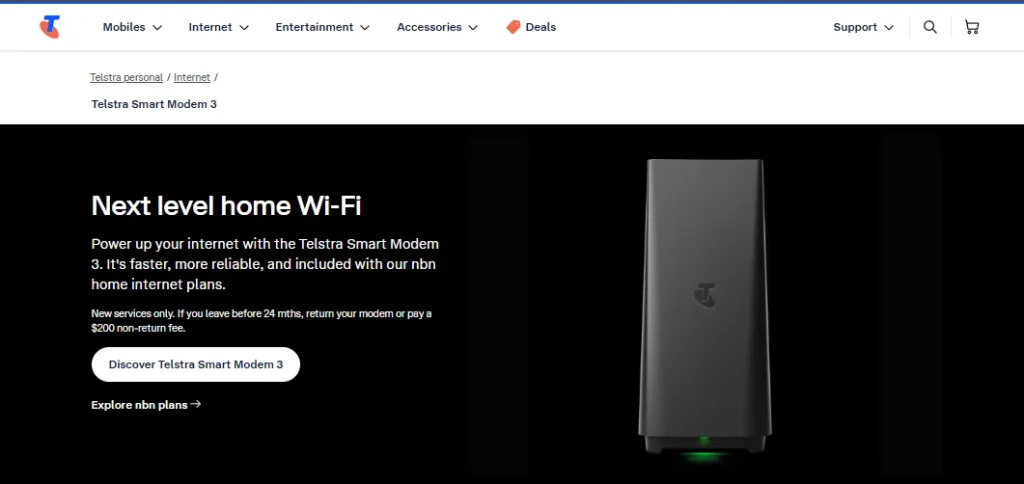
Features
The Smart Modem 3 is an excellent choice for those who want to enjoy seamless performance all the time with their Telstra connection, thanks to its amazing features.
- The dual-band WiFi 6 ensures fast and reliable wireless connections throughout your home.
- Offers improved speed and performance for all devices with advanced parental controls and guest network options.
- Equipped with four Gigabit Ethernet ports for connecting wired devices like gaming consoles or desktop PCs.
- EasyMesh support allows seamless network expansion using a compatible extender.
- Integrates seamlessly with Telstra’s Smart Home ecosystem, allowing users to expand functionality with other smart devices in their home
- Includes built-in VoIP ports for NBN phone services directly through the modem.
Pros
- Seamless 4G backup for uninterrupted connectivity
- Excellent integration with Telstra services
- Strong WiFi 6 performance
- User-friendly app for easy management
Cons
- Only available with Telstra NBN plans
- Limited customization options compared to some third-party modems
Criteria Evaluation
- NBN Compatibility: 5/5
- WiFi Standard: 5/5
- Speed Capabilities: 5/5
- Dual/Tri-band: 4/5
- Ethernet Ports: 4/5
- USB Ports: 3/5
- Mesh Compatibility: 4/5
- Security Features: 5/5
- Price: 3/5 (factoring in it’s included with plans)
- Brand Reputation: 5/5
Community Reviews and Expert Recommendations
People who used the Smart Modem 3 had positive reviews as the best modem for NBN Australia, regarding its speed and range. In fact, many agree that it represents a significant improvement from older models.
Smoozy on Whirlpool Forums says, “The Gen 3 WiFi 6 is far superior in wireless speed and range. It completely removed the need for me to have a range Extender with my Gen 2.”
However, some users experienced some performance issues under heavy load. Erin L was one of them as she shared on Product Review, “Telstra Smart Modem has fallen short of expectations for a household with 6+ high-demand users/devices. The 5GHz band frequently cuts off when the network is under heavy load, requiring constant power cycling to restore connectivity.”
Industry experts recognize the Telstra Smart Modem 3 for its strong reliability, particularly appreciating the 4G backup feature. Many expressed satisfaction with the modem’s ability to maintain internet access during NBN outages.
Nevertheless, from a technical standpoint, some were frustrated with the limited advanced configuration options, which may not meet the needs of those looking for deeper customization. Additionally, the modem’s high-end features, like WiFi 6 and 160MHz channel support, might be overkill for users with lower-tier NBN plans.
Price
The Telstra Smart Modem 3 is included at no upfront cost with eligible Telstra NBN plans.
If you’re a Telstra customer, you can upgrade for an extra $12 AUD per month for 24 months, with a minimum cost of $288 AUD, which is the retail price if you buy the modem upfront.
TP-Link VX230v
Best Known for: Value WiFi 6 Performance
Are you on a tight budget? The TP-Link VX230v offers a remarkable blend of affordability and advanced WiFi 6 capabilities, ranking as the best modem for NBN Australia for budget-conscious users.
This modem-router combo holds its ground against more premium models.

It’s perfect for budget-conscious individuals looking to future-proof their home network as it ensures compatibility with the latest wireless standards.
Performance-wise, the VX230v is powered by a dual-core processor paired with 256MB of RAM for smooth and consistent operation, even with multiple devices connected. Furthermore, it features OFDMA or Orthogonal Frequency-Division Multiple Access for the same reason.
Gamers and streamers, hear the news: the modem utilises 2×2 MU-MIMO technology, which allows for efficient data transmission across several devices simultaneously, preventing lag or slowdowns in busy home environments. Plus, it supports OneMesh to expand your network by adding compatible extenders for wider coverage. Isn’t this cool?
But that’s not all. This best-value NBN modem Australia also comes with TP-Link’s HomeCare security suite, which includes robust parental controls and antivirus protection for an added layer of security, ensuring that kids and sensitive data are safeguarded against online threats.
On the downside, USB 2.0 doesn’t offer the fastest transfer speeds compared to newer USB standards, but it’s a useful feature for modest file sharing or home office setups.
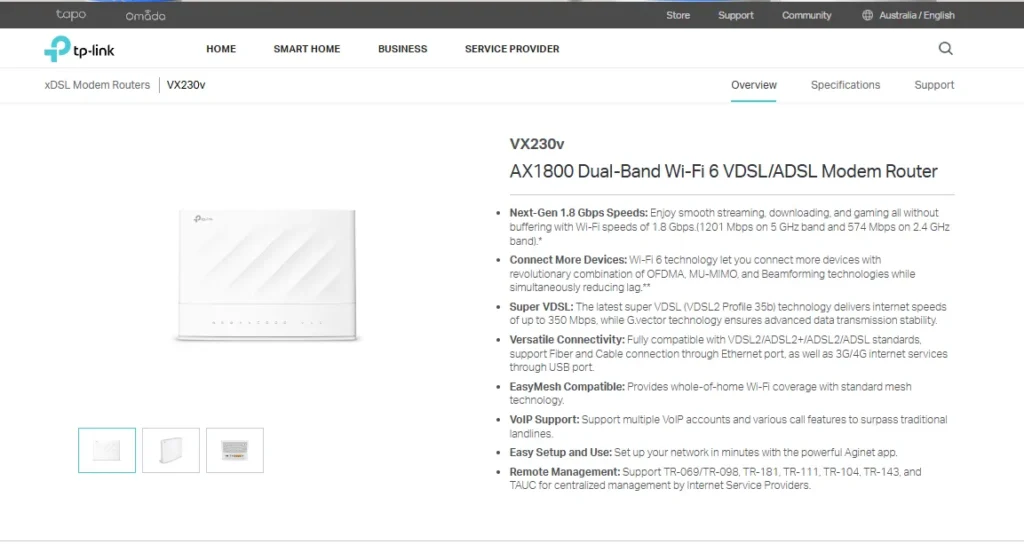
Features
A combo of affordability and excellent performance is what makes the TP-Link VX230v an excellent choice for many users.
- It delivers impressive speeds of up to 1800 Mbps, with 574 Mbps on the 2.4GHz band and 1200 Mbps on the 5GHz band for streaming, online gaming, and handling multiple devices without slowdowns.
- Comes with three Gigabit Ethernet ports to connect wired devices like desktop computers, gaming consoles, or smart TVs.
- With 1024-QAM technology, the modem offers faster data rates and improved network performance in high-internet usage situations.
- Utilises beamforming, which strengthens WiFi signals by targeting specific devices for better coverage and signal reliability throughout the home.
- The VX230v is IPv6 compatible, ensuring your network is prepared for the future.
- With TP-Link’s Tether app, users can set up and manage their network effortlessly.
Pros
- Excellent value for WiFi 6 performance
- Easy setup and management
- Solid security features included at no extra cost
- Compact design
Cons
- Only three Ethernet ports
- USB port limited to 2.0 speeds
Criteria Evaluation
- NBN Compatibility: 5/5
- WiFi Standard: 5/5
- Speed Capabilities: 4/5
- Dual/Tri-band: 4/5
- Ethernet Ports: 3/5
- USB Ports: 3/5
- Mesh Compatibility: 3/5
- Security Features: 4/5
- Price: 5/5
- Brand Reputation: 4/5
Community Reviews and Expert Recommendations
Users explained that you don’t have to break the bank to enjoy NBN, as DowneyGray explained on Reddit, “The tp-link vx230 is the cheapest wifi 6 modem on the market.”
InternalBleeding on Whirlpool Forums highlighted its stability for the average user, given its affordable price, “Nothing wrong with the VX230v. It’s wifi 6 and is pretty Ok for an average home.”
However, users didn’t highlight any specific features except its affordability compared to other models on the market.
Some even highlighted that customer support regarding setup was a bit unpleasant, as Don Lane explained on Product Review, “It seems there’s a bit of confusion regarding the support channels for TP-Link products, particularly the VX230v modem router. TP-Link’s initial communication emphasised reaching out to their technical support team for assistance. However, in this specific case, they now state that since the VX230v is an ISP-specialised model, one must contact their ISP for any technical support regarding issues with the modem router regarding setting up of IPV6.”
Experts agree that while the VX230v is suitable for budget-conscious users, some issues exist with the OneMesh support. It works fine for an average household, but performance can be dodgy with multiple devices connected at the same time, especially in a large home.
Price
The TP-Link VX230v usually retails between $150-$200 AUD.
D-Link R15 Eagle Pro AI
Best Known for: AI-Enhanced Performance
Prepare for the future with AI technology, supported by the D-Link R15 Eagle Pro AI modem. You can think of it as a new generation of NBN modems as it uses machine learning to optimise your network’s performance, depending on your usage patterns.
While it doesn’t have all the bells and whistles of pricier options, it’s a solid choice for budget-conscious users.

It works for NBN users who need reliable performance when several devices are connected to the network.
This trustworthy modem features a quad-core processor for improved performance. So, where’s the catch? It’s not the fastest modem.
Despite not being perfect, its speeds suit most household needs. But that’s not all. The voice control also supports integration with smart home systems like Alexa and Google Assistant and the mobile app allows for easy setup.
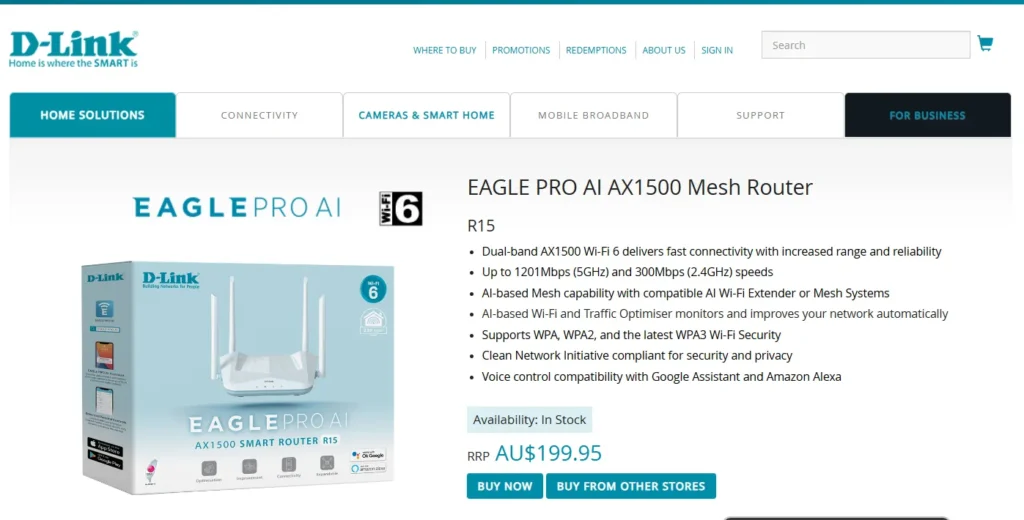
Features
This router has excellent features that appeal to many users.
- The D-Link R15 Eagle Pro AI has a convenient speed of 1500 Mbps (300 Mbps on 2.4GHz + 1200 Mbps on 5GHz).
- It features three Gigabit Ethernet and one USB 2.0 port for basic network sharing.
- Implements BSS Colouring to reduce interference in crowded environments.
- The Target Wake Time or TWT technology improves battery life on connected devices.
- AI-powered mesh capabilities for seamless expansion with compatible extenders.
- Performance improves over time with regular firmware updates to improve AI algorithms and add new features.
- WPA3 encryption for enhanced online security.
Pros
- AI optimization improves performance over time
- Compact and stylish design
- Easy setup and management through the mobile app
- Good value for WiFi 6 features
Cons
- Limited Ethernet ports
- USB port is only 2.0
Criteria Evaluation
- NBN Compatibility: 4/5
- WiFi Standard: 5/5
- Speed Capabilities: 4/5
- Dual/Tri-band: 4/5
- Ethernet Ports: 3/5
- USB Ports: 1/5
- Mesh Compatibility: 4/5
- Security Features: 4/5
- Price: 4/5
- Brand Reputation: 4/5
Community Reviews and Expert Recommendations
D-Link R15 Eagle Pro AI has a lot of good reviews from users who love that it’s easy to set up and straightforward to use. Thomas Newton from Tech Advisor loves that the router automatically scans the network for the best performance, “D-Link’s AI WiFi Optimizer software, which is turned on by default, automatically scans for the least congested radio channels, and sends you a weekly home network traffic report.”
However, John R. Delaney on Broadband Buyer mentioned that this router’s performance can be mediocre compared to other models, “The D-Link R15 gives you WiFi 6 at a rock-bottom price. It’s easy to install and can be used to create a mesh network, but its throughput and signal performance are a bit behind the pack.”
Router and modem experts agree that most users experience connectivity performance upgrades within weeks of use, thanks to AI optimization technology.
On the other hand, more tech-savvy users might not have all their needs covered when several devices are connected to the D-Link R15 Eagle Pro AI.
Price
The D-Link R15 Eagle Pro AI typically retails for $199 AUD.
D-Link DIR-2150
Best Known for: Affordable Reliability
The D-Link DIR-2150 is another efficient offering from D-Link for those with NBN plans up to 100Mbps. Think of it as a basic yet reliable router for those on a tight budget.
This router isn’t WiFi 6, but the AC2100 speed is suitable for most basic users—streamers beware. Featuring a dual-core processor, this router is a good choice for everyday tasks.

What’s more, is that MU-MIMO technology improves the router’s performance when several devices are connected.
With compatible devices, the 160MHz channel improves the router’s performance and D-Link’s Easy QoS prioritises tasks for convenient connectivity throughout the day. Finally, the mobile app is the cherry on top as it’s pretty convenient. Nevertheless, those with more advanced needs can access the web version for more customization.
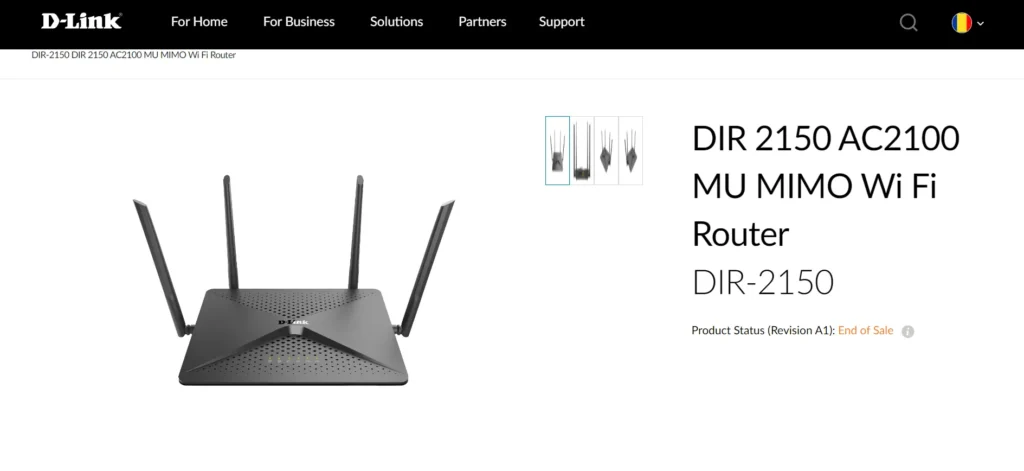
Features
The D-Link DIR-2150 has several cool features that appeal to many users.
- The AC2100 performance with speeds up to 2100Mbps (300Mbps on 2.4GHz + 1733Mbps on 5GHz) is suitable for most households.
- Features four Gigabit Ethernet ports for wired devices and a USB 3.0 port for fast network storage or printer sharing.
- Easy-to-use WiFi app for easy setup.
- Intelligent QoS with application recognition and improved performance.
- Beamforming technology for improved signal strength and range in bigger households.
- Supports IPv6 for future-proofing.
- Built-in VPN server for secure remote access.
Pros
- Affordable price point
- Reliable performance for most household needs
- Good selection of ports
- Easy setup process
Cons
- No WiFi 6 support
- The mobile app is somewhat limited compared to the web interface
Criteria Evaluation
- NBN Compatibility: 4/5
- WiFi Standard: 3/5
- Speed Capabilities: 3/5
- Dual/Tri-band: 4/5
- Ethernet Ports: 5/5
- USB Ports: 3/5
- Mesh Compatibility: 4/5
- Security Features: 3/5
- Price: 5/5
- Brand Reputation: 4/5
Community Reviews and Expert Recommendations
Many users had positive reviews about the D-Link DIR-2150, especially those who don’t need access to WiFi 6. Agent Hambo on JB Hi Fi mentioned that it was a good choice, “Really easy to set up with the Wizard. SmartConnect takes the thinking out of devices that should be on 2.4GHz or 5GHz, unlike older routers.”
Caleb Da on JB Hi Fi praised its performance, “Great value for money. The range is heaps better than the STD supplier router.”
Yet, some reviewers like Kevin Cheng on Digital Reviews Network mentioned that the router lacked some important features, “The lack of mesh support definitely hampers any expansion abilities.”
Experts agree that this router suits average-sized homes with moderate needs. The D-Link DIR-2150 has an acceptable range and performance is fairly satisfactory. However, some problems will arise if too many devices are connected.
Price
The D-Link DIR-2150 typically retails for around $180 AUD.
Sagemcom F@st 4315
Best Known for: ISP-Provided Reliability
If you work with specific internet service providers like Internode and iiNet, you can get a Sagemcom F@st 4315 modem router. It’s different from other devices which you can find at various retailers and it doesn’t deliver a flashy performance. Yet, it still made it to our list as it satisfies the needs of most users on mid-tier NBN plans.

The Sagemcom F@st 4315 is a reliable choice with a dual-core processor that suits most average everyday tasks in Australian households. With MU-MIMO, you can enjoy consistent performance if several devices are connected.
This device overcomes problems that people usually face due to limited range and performance by implementing beamforming to improve signal strength and basic QoS to prioritise traffic.
Generally speaking, it’s a good choice as long as you don’t need a router for extensive use. Still, the web configuration interface is a bit challenging to use.

Features
The F@st 4315 offers decent features that suit most households and businesses.
- The AC1600 WiFi performs with speeds up to 1600Mbps (300Mbps on 2.4GHz + 1300Mbps on 5GHz.).
- It includes four Gigabit Ethernet ports for wired devices and USB 3.0 for network storage.
- The web interface provides access to basic configuration options.
- Ready for future technologies with IPv6.
- Provides basic parental controls and guest network functionality.
- Offers VoIP to support NBN phone services.
- Firmware updates through ISP partnerships improve its performance.
Pros
- Reliable performance for most household needs
- Often provided at no extra cost with eligible ISP plans
- Good selection of ports
- Vertical stand option for flexible placement
Cons
- Limited availability outside of specific ISPs
- Lacks advanced features found in some retail modems
Criteria Evaluation
- NBN Compatibility: 5/5
- WiFi Standard: 3/5
- Speed Capabilities: 3/5
- Dual/Tri-band: 4/5
- Ethernet Ports: 3/5
- USB Ports: 4/5
- Mesh Compatibility: 2/5
- Security Features: 3/5
- Price: 4/5 (considering it’s often included with plans)
- Brand Reputation: 3/5
Community Reviews and Expert Recommendations
Many users were satisfied with their Sagemcom F@st 4315 devices that were provided by their internet providers.
For starters, they admired its stability as Fyeahm explained on Product Review, “Received this modem as a replacement from Belong on their ADSL2+ plan, to replace the old Technicolor TG797n V3 modem. Left Belong to sign up with Aussie Broadband NBN and it turned out that this modem has NBN capabilities! Saved me $150 from getting a new modem just for the new NBN service. And it worked flawlessly from the get-go.”
However, the WiFi range was a bit underwhelming for some. Breadcrumb on Whirlpool Forums explained, “Two of us living in a 1-bedroom apartment are using 2 laptops and 2 mobile phones. Still, the Belong F@st 4315 modem-router can’t take the load. It even struggles to open a website.”
Experts believe that this router is a good choice for most average users, though. It’s budget-friendly and offers decent performance most of the time.
The lack of advanced features can be a drawback, although it had positive feedback for its VoIP call quality for NBN phone services. Extra access points might be needed for larger homes.
Price
The Sagemcom F@st 4315 is typically included at no upfront cost with eligible iiNet and Internode NBN plans.
Google Nest WiFi
Best Known for: Smart Home Integration
The Google Nest WiFi system is your gateway to the future with seamless smart home integration and reliable internet coverage. This isn’t a traditional modem-router combo, but it’s a great addition to your existing NBN modem, thanks to its user-friendly mesh system.
Since it’s provided by Google, this device quickly integrated with Google’s ecosystem.

It also has an attractive design that won’t look out of place, so you won’t have to look for DIY ways to conceal this device.
Featuring a quad-core processor and 1GB of RAM guarantees excellent performance while streaming and gaming, regardless of the number of devices connected. You’ll barely deal with any slowdown or outages, as it implements automatic channel selection to reduce interference.
Additionally, the Nest WiFi uses machine learning to optimise network coverage and the device’s performance based on your usage. Finally, all your online data will be safe thanks to the WPA3 encryption.
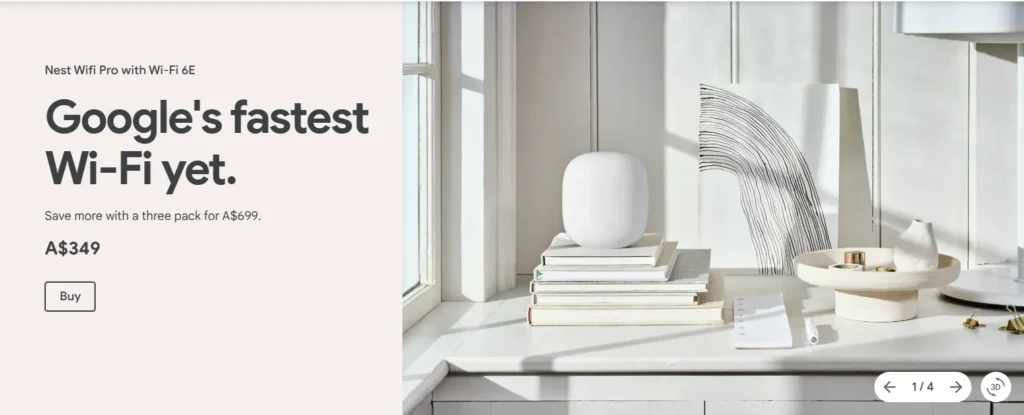
Features
The Google Nest WiFi has many fans, thanks to its outstanding features.
- The 2200Mbpsspeeds across its dual bands provide solid AC2200 performance for most users.
- Features two Gigabit Ethernet ports, while additional mesh points double as Google Assistant smart speakers.
- Supports beamforming for improved signal coverage in bigger areas.
- Includes Network Assist technology for seamless roaming between mesh points.
- Proactive band steering to optimise device connections.
- The Google Home app provides an intuitive setup process.
- Easy management of your network with features like guest networks and parental controls.
Pros
- Extremely user-friendly setup and management
- Attractive design that blends into home decor
- Seamless Google Assistant integration
- Expandable mesh system for larger homes
Cons
- No WiFi 6 support
- Limited Ethernet ports
- Requires separate NBN modem
Criteria Evaluation
- NBN Compatibility: 4/5 (requires separate modem)
- WiFi Standard: 3/5
- Speed Capabilities: 4/5
- Dual/Tri-band: 4/5
- Ethernet Ports: 2/5
- USB Ports: 1/5
- Mesh Compatibility: 5/5
- Security Features: 4/5
- Price: 3/5
- Brand Reputation: 5/5
Community Reviews and Expert Recommendations
Most users have positive feedback regarding how this device works. They explain that it integrates seamlessly with Google’s Smart Home and doesn’t experience any lags or performance issues.
Eckless2 on Reddit had an interesting opinion, “People who have good experiences rarely post their experiences online. Yes, be aware of the bad reviews and see if any are “deal-killers” for you, but I have 3 of these and once set up, I’ve forgotten about them because they work.”
DetectiveGuyBrush on Reddit agreed, “Yeah I have three of them and they are great and do a great job in my (quite frankly) bizarre-shaped house.”
However, Snyders6flagmattress had a different experience as they explained on Reddit, “Set up 3 units today and it went seamless —- for the most part. I cannot for the life of me get my Laptop to connect to the 6ghz band. Hell, it’s showing that it’s operating on the WiFi-4 protocol (802.11n). WPA3 on or off doesn’t make a difference.”
Experts believe that the Nest WiFi is a solid device that rarely faces any issues. No router is perfect and hiccups are expected every now and then, but its user-friendly interface and consistent performance are big pluses.
Most experts highlighted the efficiency of parental controls but since you need a separate NBN modem, this might not be the right choice for everyone.
Price
The Google Nest WiFi typically retails for around $250-$350 AUD for a two-pack (router + one mesh point).
Synology RT6600ax
Best Known for: Advanced Features and Customization
The Synology RT6600ax packs too much power for the average user. It’s more suitable for tech enthusiasts, streamers, gamers, and those who need range and coverage.
If you have a home office or increasing network demands, the tri-band WiFi 6 performance and NAS-like features will make it an excellent choice.

One of the most appealing features is its 160MHz channels for maximum WiFi 6 throughput.
Synology RT6600ax’s quad-core 1.8GHz processor and 1GB RAM deliver high-performance operation in most situations. It utilises Smart Connect for intelligent band steering and includes Synology’s robust SRM (Synology Router Manager) operating system.
While it might be packing too much power for most Australians, it should be your go-to option if you live in a busy household or need a modem for your office.
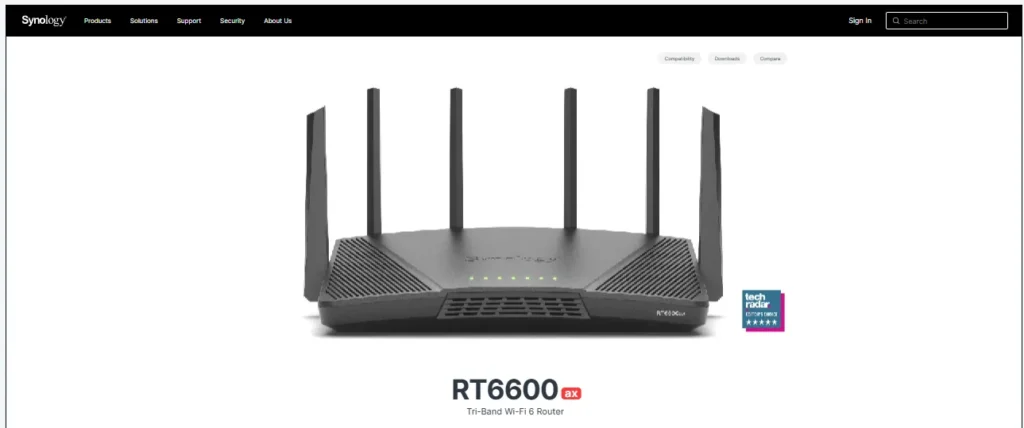
Features
Several appealing features make the Synology RT6600ax stand out.
- It features impressive tri-band WiFi 6 performance with theoretical speeds of up to 6600Mbps across its three bands.
- Includes four Gigabit Ethernet ports, one 2.5GbE port for high-speed WAN or LAN, and a USB 3.2 Gen 1 port for network storage.
- Synology’s SRM software provides a wealth of advanced networking tools and security features typically found on enterprise-grade equipment.
- It supports multiple SSIDs and VLANs for network segmentation.
- Includes QoS with application-aware traffic shaping.
- Has a built-in VPN server for client functionality.
- Supports Docker containers for running additional services.
Pros
- Exceptional WiFi 6 performance
- Highly customizable with advanced features
- Powerful SRM operating system
- 2.5GbE port for future-proofing
Cons
- Expensive compared to most consumer routers
- May be overly complex for casual users
- Large physical size
Criteria Evaluation
- NBN Compatibility: 4/5
- WiFi Standard: 5/5
- Speed Capabilities: 5/5
- Criteria Evaluation (continued)
- Dual/Tri-band: 5/5
- Ethernet Ports: 5/5
- USB Ports: 4/5
- Mesh Compatibility: 5/5
- Security Features: 5/5
- Price: 2/5
- Brand Reputation: 4/5
Community Reviews and Expert Recommendations
Users love how reliable and solid this modem is as Richard Hendricks explained on Whirlpool Forums, “Got everything set up, hooked up a USB thumb drive to enable threat prevention. Everything works well out of the box. The smart connection is on, my M1 Max Macbook Pro is auto-connected to 5Ghz-2, and everything else is auto-connected to either 5Ghz-1 or 2.4Ghz as expected. No download or upload speed issues.”
100GigSpeed mentioned the modem’s many pros, “Fast and reliable WiFi with the support for 5.9GHz UNII-4 spectrum, mesh-ready. Robust, comprehensive yet user-friendly SRM 1.3 firmware with excellent web interface and DS Router app.”
However, Kalquaro on Reddit highlighted that it might not work for all users. “I have it and I love it, but there are less expensive options out there. I use this one because I needed dual-wan support and most of the software features that are targeted at power users.”
Experts highlight its powerful software and exceptional performance, especially for those who need a consistent network connection while streaming or uploading software, and many consider it the top-rated NBN modem Australia. However, it might be an overkill for the average user.
Price
The Synology RT6600ax typically retails for around $400-$500 AUD.
Notable Mentions
So, what if none of the options we suggested work for you? Here are good modems to consider:
TP-Link VX220-G2v
The TP-Link VX220-G2v is a solid device with VDSL support, ideal for FTTN and other WiFi 6 connections.
ZTE H1600
With dual-band WiFi 6 and multiple WAN access, the ZTE H1600 offers reliable performance for most users.
Optus Ultra WiFi Modem Gen 2
The Optus Ultra WiFi Modem Gen 2 is specifically for Optus customers with 150% faster speeds and access to WiFi 6.
Vodafone WiFi Hub 3.0
If you’re a Vodafone customer, the Vodafone WiFi Hub 3.0 will be a solid choice with WiFi and 4G backup.
Frequently Asked Questions
What’s the difference between a modem and a router?
A modem translates signals from your internet service provider to a signal your device can use to get connected to the internet. A router creates a local network by distributing this connection over multiple devices.
Most of the devices we listed in this guide combine both functions, becoming what we call modem-router. But for more specific needs, you can check our guide for the best VPN router.
Do I need WiFi 6 for my NBN connection?
You don’t necessarily need WiFi 6 for your NBN connection but having one comes with a lot of perks. Mainly, you’ll enjoy improved performance in crowded environments and you’ll immediately notice the difference. This includes higher speeds, fewer or no outages, and even better battery life for your devices.
Other technical aspects include the new OFDMA and BSS Colouring technologies, although performance will be highly dependent on your devices’ compatibility.
So, although upgrading to WiFi 6 is a personal choice, it’s highly recommended if you use too many wireless devices or plan to upgrade to faster NBN tiers. Learn about the best NBN fixed wireless plans here.
How do I choose the right NBN modem for my connection type?
It depends on your NBN technology and it’s highly recommended to consult your ISP before making a purchase. So, for example, any modem/router will work for FTTP and HFC connections. However, FTTN and FTTB connections require a specific device with VDSL support. On the other hand, FTTC users need a modem compatible with FTTC NCD.
If you’re wondering what is good internet speed, you can click here.
Can I use my own modem with my ISP’s NBN service?
Mostly, yes. The NBN is designed to be an open-access network that allows you to use your modem. However, some ISPs strongly recommend or even require using their own device for support and easy setup. In some cases, some features like 4G backup might only work with provided modems.
How important is NBN modem security?
Online security is everything when using an internet-connected device, including NBN modems. Several features like regular firmware updates, WPA3 encryption, and built-in firewalls will safeguard your online data and family members while browsing, uploading, and downloading.
Moreover, some advanced modems take things up a notch with additional features like intrusion detection and VPN support. So, what is encryption? Read this article to learn how to improve your online safety.
Final Thoughts
Australian internet users have diverse needs, and thanks to the modems suggested in our guide, everyone will find a device that works for them.
Inevitably, there’s no one-size-fits all NBN modem. However, the right one can truly transform your internet experience. You’ll be able to enjoy faster internet speeds, fewer drops, and the benefits of WiFi 6.
When choosing, just be sure that it supports your NBN type, offers high-speed ports, and think about mesh systems for larger homes. Be on the lookout for robust security, ease of setup, and reliable after-sales support. Sometimes, the most expensive option isn’t always the best fit.
While having a great NBN modem is crucial for a smooth online experience, it’s just one piece of the puzzle. To truly protect your privacy and security online, consider pairing the best modem with a reliable VPN service.
At Privacy Australia, we’re committed to helping you navigate the complex world of online privacy and security. Our comprehensive VPN reviews and guides can help you find the perfect solution to complement your new NBN setup and enhance your online security.
Remember, the internet landscape is constantly evolving. Stay informed, keep your equipment updated, and don’t hesitate to reassess your needs as technology advances.





